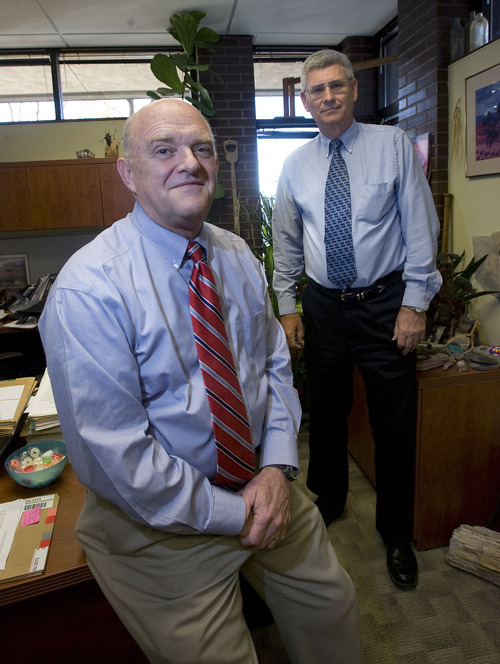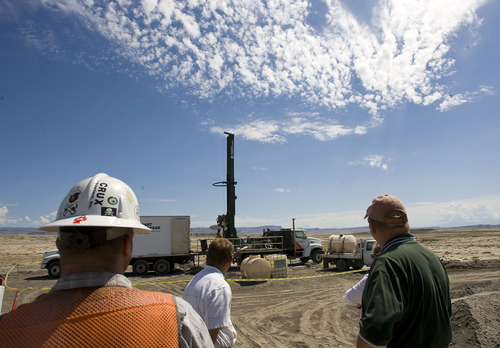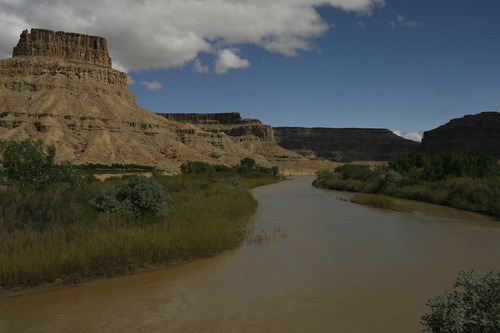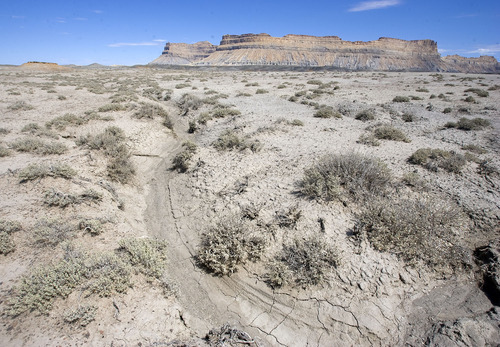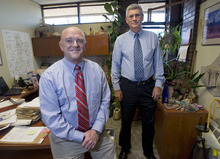This is an archived article that was published on sltrib.com in 2012, and information in the article may be outdated. It is provided only for personal research purposes and may not be reprinted.
Plans for Utah's first nuclear power plant cleared a big hurdle Friday, when State Engineer Kent Jones OK'd the use of Green River water to cool the proposed reactors.
Proponents called the decision an important step, made after lengthy and painstaking review. But critics said lawsuits are almost certain in light of the desert river's importance for farmers, recreationists, endangered fish and some of the other 25 million people who rely on the water downstream.
"The state of Utah has decided to up the contention over the Colorado," said John Weisheit, whose Moab-based environmental group was among the 200 organizations and individuals to protest the water proposal.
"There's going to be litigation between the states," he predicted, "because [Utah officials] are allocating water that isn't there. Someone upstream or someone downstream is going to suffer."
In what is expected to be the state's only regulatory decision on the power plant, Jones said he focused on the law related to the request by water districts in Kane and San Juan counties to lease 53,600 acre-feet of their unused water rights to the power plant developers. After more than two years of study, he said, he and his staff found that Blue Castle LLC's request would not harm other water users, wasn't speculative and that there was water available, even during drought.
"From what we were looking at," he said, "there is adequate water for this project."
Jones acknowledged he'd fielded many concerns over safety and oversight, as well as water allocations and financial feasibility of the project. But state law guided his conclusion, he said.
"We have listened to and very much appreciate the concerns raised by those in the local community and others," Jones said in a statement. "Those concerns helped us look carefully and critically at the proposal as we considered the appropriate action on these applications."
Blue Castle CEO Aaron Tilton said the decision had been long in coming but was "exactly what we expected." Without water, the project could not have gone forward, he added.
"It's one step but a hugely important step for us," said Tilton, a former state legislator. "It puts some momentum in the project."
The plant would be built on about 1,700 acres of a new industrial park in Emery County, near the intersection of State Route 6 and Interstate-70. It would include two reactors that would produce up to 3,000 megawatts of electricity.
Building the reactors is expected to cost up to $18 billion. And, if construction gets under way as planned in 2016, the plant could be generating nuclear power by 2020.
Yet, Blue Castle faces significant challenges ahead, such as completing a two-step U.S. Nuclear Regulatory Commission licensing process that is expected to cost $100 million.
And using the water is contingent on that approval, noted John Mann, assistant State Engineer. "They can't do anything," he said, "until they get the NRC approval."
NRC spokesman Scott Burnell pointed out that Blue Castle isn't expected to begin the first phase of licensing until 2013.
In that stage, the NRC looks at the proposed site broadly, asking the question 'Is this the right place for nuclear reactors?' Usually taking about three years, the analysis would include a look at impacts on the river, reductions in water levels, local housing and emergency services strains and a detailed environmental impact statement, Burnell noted. A later phase looks at the specific plant.
To approve the first-stage license, the NRC spokesman explained, "we would have to conclude that any impacts for the hypothetical power plant could be accounted for or corrected or the benefits of what's being proposed wouldn't outweigh the environmental cost."
It is not clear yet what role the U.S. Fish and Wildlife Service might play, but the agency is sure to be part of the discussion, given its charge to protect the habitat of four species of endangered fish: the Colorado pikeminnow, humpback chub, bonytail and razorback sucker.
The State Engineers' decision notes that river flows sometimes fall below the targets set under a multiagency plan to preserve and restore the endangered fish as required under federal law.
"Approval of this application has the potential to exacerbate the low-flow situation," the water-rights decision says.
USFWS fish biologist Kevin McAbee said his agency will work closely with the NRC and Blue Castle to ensure the fishes' survival.
The water-rights decision downplayed the potential impact of climate change, which some have said could cause reductions in the available water of as much as 30 percent. It also asserted that Kane County rights will take a place behind the Central Utah Project if water shortages ever become severe.
Without that caveat, the publicly financed, $3 billion CUP, serving 600,000 residents in the populated Wasatch Front, might have to defer to Blue Castle's rights during a deep drought.
Neither the governor nor Legislature has any official role in approving or blocking the project — that's now up to the NRC — but both have supported the idea of nuclear energy. Gov. Gary Herbert did not endorse the decision Friday. But his spokeswoman said "his support for specific [nuclear] projects will hinge on the safety and health of Utahns foremost."
The state's decision to OK the Blue Castle project troubled Matt Pacenza, director of the Healthy Environment Alliance of Utah.
"It's disappointing and unfortunate," Pacenza said. "The good news is the project still has many obstacles ahead of it."
Twitter: judyfutah —
Online: Blue Castle Project info
O Read more about the Blue Castle Project at the U.S. Nuclear Regulatory Commission website.
> 1.usa.gov/c3J4Xs —
Community views
Pro • Mike McCandless, economic development director for Emery County, applauded Friday's water-rights decision as a critical step forward to improving life in nearby Green River City and the rest of his 1,100-population county.
"We know it's just one more step in the process," he said, "but we in the county are very excited about it."
The county estimates the plant will mean as many as 2,000 well-paying jobs. It also would roughly double the county's tax base, he said.
Con • Green River farmer Tim Vetere criticized the decision to let the power plant take the river water.
"This is going to make it harder for farmers to get the water they need out of the river," said Vetere, whose farm raises melons, sweet corn, field corn, hay and more. "Also, I'm worried that if a nuclear power plant goes in, people won't want to buy my melons."
"Pretending there is enough water in the Green River for the power plant is a mistake," says Bob Quist, the owner of Moki Mac River Expeditions, a company that leads rafting trips on the Green. "It's bad for my business and bad for everyone that depends on this river."


